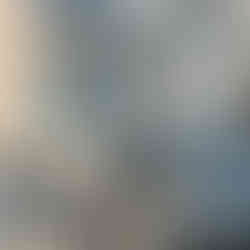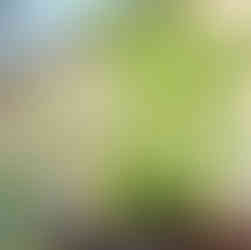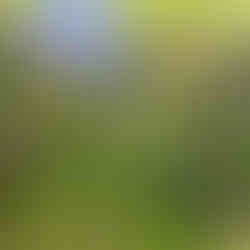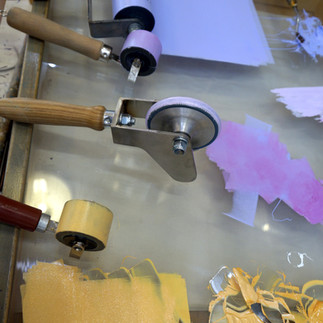Hares and Meadow Cranesbill
- Martin Truefitt-Baker, Art

- Oct 1, 2022
- 3 min read
Updated: Mar 26, 2024

This reduction linocut was inspired by a trip out in July this year while I was walking through some fields where the meadow cranesbill (wild geranium)were having a first full flush of flowers. The hares were still mad and charging around but mainly in the wild plants and grasses in the margins. One hare crashed through a patch of flowers just as another one jumped over it. They both look a bit startled, the scattered petals and the blue/purple orange/brown colour contrast became stuck in my mind.
As usual I made the original design mainly in tones of blue (there's more about how and why I do this here https://www.truefitt-baker.co.uk/post/designing-linocuts-linoprints-lino-and-printing ) but I must admit I got a bit lazy. After drawing out the flower a few times I printed out flowers from some of the jpegs I'd taken as research. So the resulting design is a bit of a collage.

The original acrylic painted design alongside the scanned and reversed copy that's transferred to the lino.
Wild meadow cranesbill in the hedgerow and brought back to the studio study. They are called cranesbill because the spent flowers look like a crane's head and bill. Mokka decided I wasn't giving him enough attention so he jumped into the rubbish bag and then ripped his way out doing his 'alien bat cat' impression!o)
I've been developing the composition for a few months, it has carried on while other prints and paintings were finished. The printing of this reduction linocut was a challenge because I wanted a distinct edge for the flowers against the warm brown of the hares. I decided to use two lino plates. Both have been printed as reductions. The 'flower' plate has 2 layers and the hare and foliage plate has 5 layers. It's not what might be called a jigsaw print. I've used several of the tones from the hares to provide extra shadows and details (stamens etc.) on the flowers. Registration was difficult and lots of adjustments and tests were needed. Printing has taken nearly a month!
I must be honest, I wasn't a great fan of the Ternes Burton pins. I did try to resist paying out for some rather expensive bits of metal and plastic. Now I've found that they made registering the designs over the lino while the image is being transferred for each layer and then printing the two reduction plates much easier.
The colours for the print that I thought at first would be easy turned out to be a problem. I often try out combinations of tones and colours using watercolours. Any that involved using the natural greens of the foliage just didn't seem to work. By playing the greens right down it has allowed the simple play of opposite colours to work (I hope!)

There are 35 prints in the edition and three proofs. I started out with 45 but some fell by the wayside, misregistered or ended up with cat paw prints and were lost to the logburner. Very expensive firelighters!
This is just about my biggest print so far. The image is 40x58cm. It was printed on to full 56x76cm sheets of Somerset satin paper. The new Gunning press makes the whole process a lot easier than it was printing the two large 'fox' prints. After printing I tear the top part of the sheet away with the registration pins to leave a length of 73cm.

They are quite big when framed up! about 80x65cm
























Comments